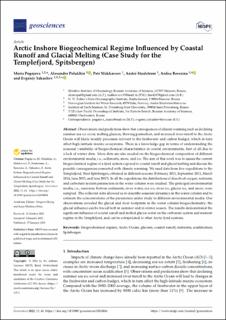| dc.description.abstract | Observations and predictions show that consequences of climate warming such as declining summer sea ice cover, melting glaciers, thawing permafrost, and increased river runoff to the Arctic Ocean will likely modify processes relevant to the freshwater and carbon budget, which in turn affect high-latitude marine ecosystems. There is a knowledge gap in terms of understanding the seasonal variability of biogeochemical characteristics in coastal environments, first of all due to a lack of winter data. More data are also needed on the biogeochemical composition of different environmental media, i.e., sediments, snow, and ice. The aim of this work was to assess the current biogeochemical regime of a fjord system exposed to coastal runoff and glacial melting and discuss the possible consequences connected with climate warming. We used data from five expeditions to the Templefjord, West Spitsbergen, obtained in different seasons (February 2011, September 2011, March 2014, June 2015, and June 2017). In all the expeditions, the distributions of dissolved oxygen, nutrients, and carbonate system parameters in the water column were studied. The principal environmental media, i.e., seawater, bottom sediments, river water, sea ice, river ice, glacier ice, and snow, were sampled. The collected data allowed us to describe seasonal dynamics in the water column and to estimate the concentrations of the parameters under study in different environmental media. Our observations revealed the glacial and river footprints in the water column biogeochemistry; the glacial influence can be traced both in summer and in winter season. The results demonstrated the significant influence of coastal runoff and melted glacier water on the carbonate system and nutrient regime in the Templefjord, and can be extrapolated to other Arctic fjord systems. | en_US |

